Is santa fe #5000 being restored to Operational status or just cosmetic??
I have been to thier FB page & thier website ,nothing is really being discussed or stated.Anyone have any insider news??
Is santa fe #5000 being restored to Operational status or just cosmetic??
I have been to thier FB page & thier website ,nothing is really being discussed or stated.Anyone have any insider news??
Since Santa Fe’s second 2-10-4 has been retired and on display since the late 1950’s, I’m sure that only a cosmetic restoration is being planned.
AT&SF’s first 2-10-4 - a 3800 class 2-10-2 with an experimental 4 wheel trailing truck…63 inch drivers…

A close cousin - 3800 class 2-10-2 with standard 2 wheel trailing truck…63 inch drivers…

Madame Queen - AT&SF’s second 2-10-4…69 inch drivers…

5001 class 2-10-4…74 inch drivers - as high or higher as found on many dual service 4-8-2 and 4-8-4 locomotives…

5003 on tonnage…

AT&SF 5011 class 2-10-4…74 inch drivers…

5033 on tonnage…
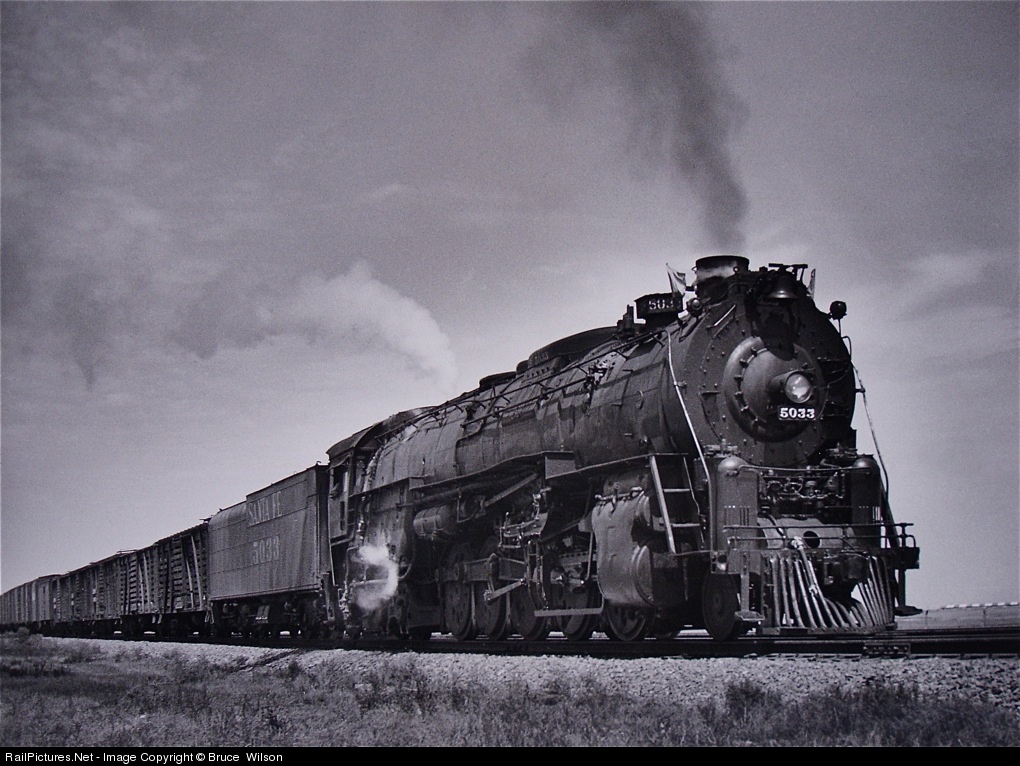
5023 on varnish…
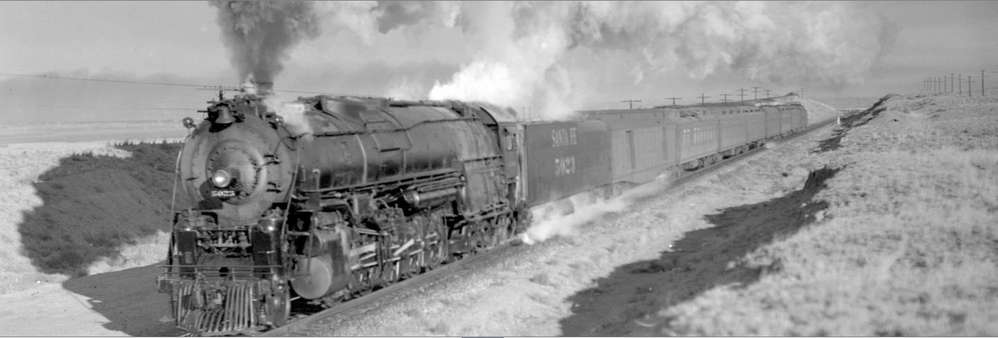
I got this from a retired ATSF engineer that retired in 1989 he lives near me he started at the end of steam. He told me that the 5011’s where used a lot on the troop trains according to the old hands he trained from. They could get those over the rails as fast as the 3460 class and did not need helpers over Raton pass at all with up to 30 cars behind them.
i talked to the 5000 group on FB
turns out they want to restore it to Operational status. They are working with amarrillo to make ot happen
“MADAME QUEEN”
The AT&SF 5000 was a unique engine unlike any of her sister locomotives. The name given to her hides a significant story.
The Atchison Topeka and Santa Fe Railroad adoped 5 coupled axle steam power for freight railroad service in early 1902, choosing to use the 5 axle approach for their 2-10-0 tandem- compound “Decapod” series of freight engines. Difficulty in running these engines backwards caused the railroad to rethink is freight locomotive design and choose instead to go with the 2-10-2 “Santa Fe” type engine in 1903.
A total of 160 of these 2-10-2 engines were built between 1903 and 1906. The last of these 2-10-2 “tandem-compound” locomotives was altered, however, to “simple” or “single expansion” construction. It was also modified to include the newly developing concept in steam locomotive technology - the use of the high efficiency and high power locomotive “superheater.” Changes that showed the things that were to come.
Between 1912 and 1913 a new 2-10-2 engine design was built with the addition of 32 locomotives featuring the “single expansion cylinders” and “type A superheaters” envisioned in 1906.
By 1918 another completely new re-design of the 2-10-2 “Santa Fe” type engines was in the works, to be called the 3800 Class locomotive. Constructed after the First World War from 1919 thru 1927 a total of 141 of this 3800 Class 2-10-2 locomotive was built.
Of these engines, in 1919 was one experimentally altered locomotive - ATSF 3829 - was constructed with a 4 wheel trailer t
Some of that may apply, but I suspect ATSF people will confirm they called her that because of a radio-show character – not a politically correct one by today’s standard. Madam(e) Queen was a character on the Amos 'n Andy show… this is similar to what happened with the original Aeolus (‘king of the winds’) locomotive 4000 on the Burlington – which was irreverently called “Big Alice the Goon” after the Thimble Theater (Popeye) character. (Railroaders cannot be expected to pronounce Greek accurately.)
I recall reading that the high mounted Elesco feed water heater, unusual on ATSF locomotives at the time, reminded someone of a show character named “Madam Queen” who wore her hair in a roll (or bouffant) at the front, otherwise as posted above.
M636C
WHY WAS MADAME QUEEN THE ONLY ONE?
ATSF 5000 was the only engine in its class - why? The Santa Fe Railroad had the tradition of building one “pathfinder locomotive” when planning engine design for future needs. We can see this in the early 2-10-2 locomotive development of 1906 when the last engine of an order of 160 “tandem-compound saturated steam” engines was built as a “single expansion superheated engine.” Likewise, in 1919 an order was placed for 140 additional 2-10-2 locomotives of the 3800 Series class locomotives to be produced thru the year 1927. One of these 3800 Series 2-10-2 locomotives was built as a 2-10-4 and so remained through out its service life. Apparently satisfied with this 1919 version of the 2-10-4 design the railroad in 1930 after 11 years of development went ahead with another “one off” 2-10-4 of grand proportions - the ATSF 5000 MADAME QUEEN.
But what did all this lead up to - one experimental 2-10-4 of the 3800 Class and one experimental 2-10-4 of the 5000 Class? These engines constitute over twenty years of “one off” experimental design work. The first engine built in 1919 and the second in 1930.
An order of 10 mammoth 2-10-4 freight engines in 1939 of the 5001 Class, and a second order made during the Second World War of an additional 25 engines of the 5011 Class. This last group would go down as the “truely ultimate MASSIVE SANTA FE POWER.” So well liked were these big 2-10-4 engines, that Santa Fe could not bring itself to scrap them all.
Yes, like the UNION PACIFIC RAILROAD with its massive BIG BOY 4-8-8-4 locomotives the railroad saved almost 20% of these engines from scrap, so also did SANTA FE save 5 locomotives out of the 36 engines that it buil
I’m not absolutely sure of this, but I believe that the 5011 class (and the 2900 class) were ordered by Santa Fe only because of the inability to order additional FT’s because of wartime restrictions.
Principally because in the intervening years between her design and the later 2-10-4s a number of interesting design and detail evolutions took place. By the time in the mid-to-late Thirties that lightweight rodwork would have made the Queen truly suitable for higher speed, the more sophisticated, much bigger, much faster 74"-drivered classes were ‘where the money should go’ for any further ten-coupled orders of any prospective use.
I don’t think you can practically say that either the later 2-10-4s or the 2900 class ‘wouldn’t have been built’ in favor of FTs. That was certainly one point Brasher seemed to establish in his (fairly) recent book, but there is a bit more to the story, which I think is common to among other things the introduction of the PRR Q2s.
It is not a nit-picking point to establish that the “2900s” weren’t a thing the ATSF would rather have gotten FTs for – those, themselves, were the result of WBP production restrictions; the actual comparative target would be more 3765 or 3776 class engines. The ‘catch’, of course, was that the increased wartime traffic combined with hard restrictions on high production of EMD or any other practical diesel-electric road power would have called for more big high-horsepower and high-speed steam. Wartime conditions were tailor-made for very long trains, run at high speed with idealized meet and yarding conditions, with guaranteed high tonnage. Here is where the somewhat strange-looking construction of multiple divided-drive locomotives of massive horsepower (in fact, so high a horsepower that achievable water rate limited the range even with enormous tender cistern capacity) that made best power more than 10mph over PRR’s own freight speed restriction made sense. Remember that when the Q2s were greenlighted and built, there was no prospective end to the war. Turning t
THE FATE OF ATSF 5021 -
Santa Fe, like Union Pacific for corporate purpose saved several of its historic steam locomotives. Saved in Cheyene, Wyoming were Challenger UP 3895 and Big Boy 4023 both low milage engines in excellent condition. Also saved and continuiously used were passenger Northern UP 844. Engines kept indoors and away from the theft and vandalism common to most surviving steam. For almost 50 years these engines were preserved in this way representing the best of what could be kept.
Santa Fe also participated in a similar corporate historic preservation effort by keeping “Northern” ATSF 2925 and “Texas” ATSF 5021 indoors moving them once a year to keep their roller bearing drive train from freezing up.
Either the proposed corporate merger with Southern Pacific or the actual corporate merger involving the Santa Fe with Great Northern and Burlington to form BNSF caused the railroad to, without much thought, seek a location to donate these two engines which after 50 years were forced from their protected home to outdoor industrial storage.
For the first time they were stripped of their collectable parts for protection from theft and painted primer red. These fantastic locomotives were given without much thought concerning their fate to the California State Railroad Museum in Sacramento, CA. Here without proper care and facility for restoration they have been forced to languish and be vandalized for years in the elements of a fairly rainy climate.
Among the best preserved of the ATSF 5000 locomotives what will be the fate of the prize of the company - ATSF 5021?
California - hell of a great place!
Doc
Best preserved of the ex-ATSF 2-10-4s might now fall to 5017, indoors at the National Railroad Museum in Green Bay, WI.
While it is not a 2-10-4, at least 2926 down in New Mexico should soon be able to show us what a 1940s state-of-the-art, big-barreled Baldwin can do.
I’m sure that big-barreled Baldwin will do VERY well when it hits the road.
Not as well as something from Roanoke mind you, but pretty well indeed! ![]()
While this was a miserable situation indeed, it has been recently reported in RyPN that added effort has been put into protecting and perhaps ‘cocooning’ these locomotives until a better home can be found for display.
WHAT? - ANOTHER MADAME QUEEN!
Trains Magazine, February 1950 - page 12 - YES!
David P Morgan titled “TRAINS - The illustrated magazine about railroads.”
The February issue accounts stories of the Missouri Pacific Railroad and its experimental roundhouse queen three cylinder engine conversion to two cylinder poppet valve - MP 6001 affectionately named by the railroad MADAM QUEEN.
"North Little Rock Shops and the Franklin Railway Supply people took a hand in No. 6000’s destiny in November, 1942. Franklin was and is selling a new version of poppet valves that promise 16 per cent more horsepower at 40 miles per hour, almost 30 percent more at 88. Mopac thought the plan had possibilities and selected the three-cylinder Pacific as a convenient test lab since it was obvious that the 6000 was a misfit for anything else on the railroad, excepting scrap.
Little Rock did a good job. In place of three cylinders came just two, actuated by Franklin Type A poppets; oil replaced coal as fuel. In addition the Mopac put the engine on roller bearings, modernized her with such equipment as an Elesco exhaust-steam injector and new rods, and gave her the number 6001 - otherwise known as MADAM QUEEN.
The QUEEN again fell down during the first three months of her rebuilt life - but after that the 6001 turned out to be the equal of an MP Mountain type. Usually where a 4-6-2 of the 6001’s weight was allowed 10 cars, a 4-8-2 could handle 14. The QUEEN not only rearranged the tonnage-rating chart for her wheel arrangement but also ran off 102,000 miles in a 12 month period over the road’s Arkansas and Memphis divisions. Throughtout the duration of the war, when the Mopac shouldered its load with steam, the 6001 was reckoned to be a mighty valuable engine to have around the Ozarks." (p. 12-13&nbs
ATSF 5017 under cover at the National Railroad Museum in Green Bay, WI…

ATSF 5000 Madam Queen in revenue service - doubleheading with what looks to be a 3800 class 2-10-2…
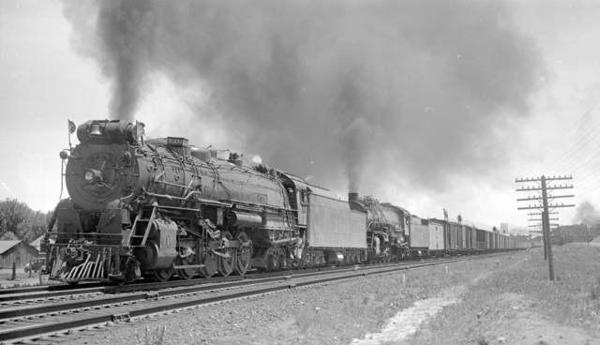
ATSF 5000 Madam Queen in revenue service broadside…
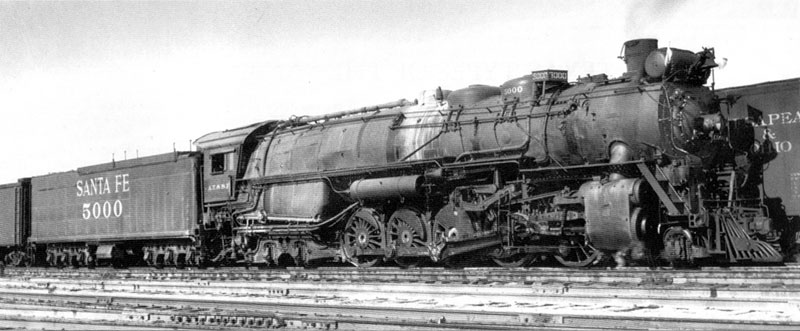
A robust Missouri Pacific Pacific - I could not find a picture of 6001 but this Pacific has the high-mounted Elesco feedwater heater like ATSF 5000…

Definitely not Madam Queen, but I came across this rebuilt MoPac Atlantic - pretty impressive for a rebuild of smaller power…
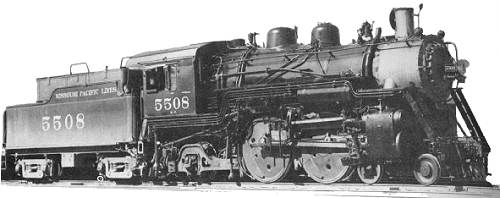
Missouri Pacific 4-8-2 Mountain - that 4-6-2 6001 must have really been souped up to match the performance of these large Mountains…
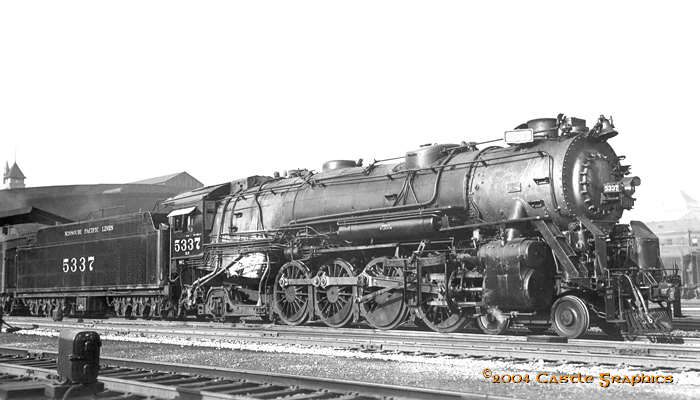
ATSF 2926 in revenue service - a big-barreled Baldwin comin’ right at ya…

ATSF 2926 in proper working order on the West Coast…

Another ATSF 2900 class - 2903 hitting the water plug…
The disc drivers on MP 5508 look out of place, it looks like a 4-8-2 that had a center section of the boiler and frame removed.
MP 6001 (and others) showed how much of a difference that poppet valves could make in performance.

6001 certainly didn’t have a high-mounted Elesco heater after rebuilding, but she had something more exotic - an Elesco ES ‘poor man’s feedwater heater’ ESI. Here she is in North Little Rock in mid-1943.
There is another Trains article, in late 1978 if I remember right, that covers this locomotive.
That locomotive is more impressive than it looks – I read something about it many years ago, and if I recall correctly it was intended to be a home-brewed version of high-speed power for light trains (following the general Hiawatha model for competing with motor trains, with lightweight rods, rebuilt steam passages, and a variety of other changes to modernize it. If I’m not mistaken it also includes a booster to give it the equivalent of six-coupled starting adhesion and low-speed practical TE, like other Atlantics on (IIRC) SP and C&NW that could combine good starting characteristics with economical running. (Wasn’t there a mention in that book on 'trains of the ‘40s’ that described one of the SP Atlantics successfully handling a main train with something like 21 cars? - that was the secret.)
It does look as if Karen Parker has been having some fun with more familiar Scullin-drivered power, doesn’t it?
Thanks for the shot of that Class J, kgb! Even if she’s (eek!) nekkid!
Those N&W J’s were awesome machines, even without the streamlining.
Great shot of that NYC Hudson as well, it looks to me like it’s on the old Iona Island trestle near Bear Mountain NY on the West Shore Line, now CSX’s River Subdivision. And if you wanted to be in the right hand seat that’d be the place to be, the scenery’s just gorgeous up there, although going south as the train seems to be the fireman’s got the best view.